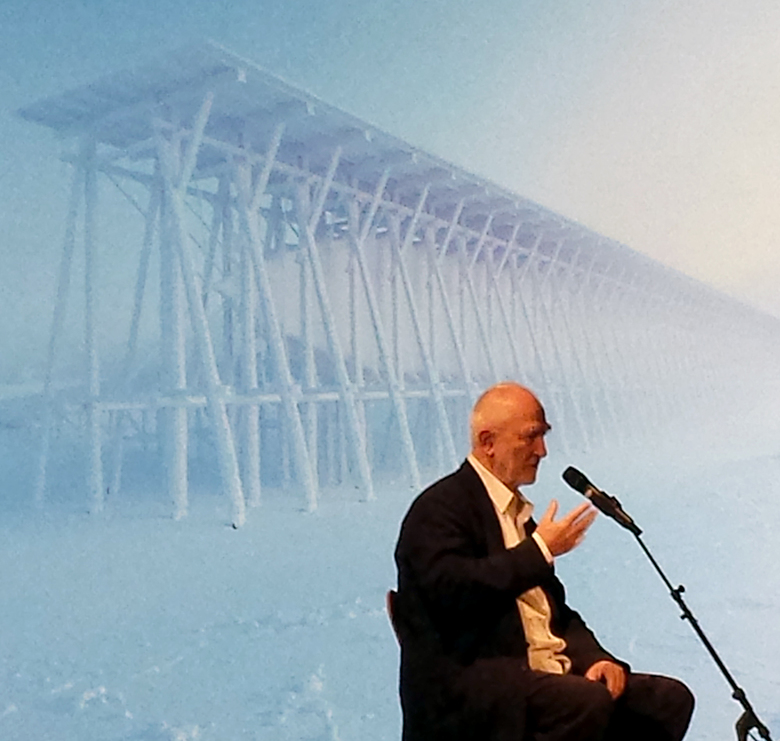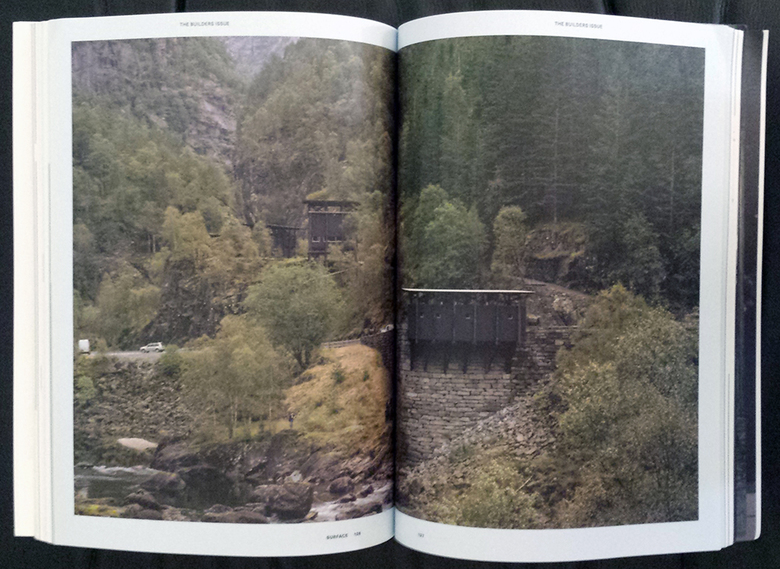Peter Zumthor, Beneath the Surface
On Friday evening architect Peter Zumthor spoke with architecture critic Paul Goldberger in front of a packed house at the Guggenheim Museum in New York City. The event was the 34th iteration of Surface magazine's Design Dialogues series.
The Pritzker Prize-winning Swiss architect graces the February cover of Surface, which is subtitled "The Builders Issue." The cover story focuses on Zumthor's design of the Allmannajuvet Zinc Mining Museum, which is located near Sauda, a good six-hour drive west of Oslo.
Design Dialogues No. 34 was co-sponsored by the Royal Norwegian Consulate General, fitting given that the Mining Museum and the Steilneset Memorial in Vardø, in northern Norway, are Zumthor's two most recently completed permanent projects – the museum in 2016 and the memorial in 2011 (the same year as the temporary Serpentine Gallery Pavilion). Both projects are part of Norway's famous National Tourist Routes, which consist of numerous architectural interventions strung along eighteen stretches of highways.
Nina Berre, who curated the 2006 exhibition Detour. Architecture and design along 18 National Tourist Routes, began the evening with a fairly academic talk about the program and how it relates to cultural views of nature in Norway and is a breeding ground for contemporary architecture. She presented a few well known interventions – Reiulf Ramstad Arkitekter's lookout in Trollstigen and Saunders Architecture's Aurland Lookout among them – but made sure to highlight Zumthor's two projects. Even though he is the only architect from outside of Norway to build for the National Tourist Routes, Berre found parallels between Zumthor's approach to nature and that of Sverre Fehn, Norway's most famous modern architect.
Following Berre's ten-minute talk, Zumthor took to the stage to present the two Norwegian projects, starting with the Mining Museum. Echoing the Zumthor quote that graces the binding of Surface – "If you have an awareness of history, it comes to be part of the now" – the architect spoke in depth about history, but not in the conventional sense. Instead of history being found in texts, Zumthor said, "Landscape stores history." This corresponds to marks on the land caused by the zinc mining operations, even though they ceased over a century ago, but also the tools and other artifacts that were discovered and now make up the dramatic displays within one of the the museum's three small structures. Zumthor designed the wooden buildings to sit atop stilts and dry-stone retaining walls. They don't just look precarious; they actually shake a little bit when inside, Zumthor said.
Next Zumthor presented the memorial that commemorates the lives of 91 people (most of them women) who were suspected of being witches and then burned at the stake in the 17th century. The memorial consists of two pieces: Zumthor's long wooden structure and artist Louise Bourgeois's adjacent glass-enclosed piece. Initially, Zumthor was under the impression that the two would create one memorial. He visited the site – the actual spot where the people were killed – and immediately had the idea of a long textile space with 91 names, 91 windows, and 91 biographies suspended within a wood frame. He sent his watercolors to Bourgeois, who replied with a sketch he didn't quite understand but told her, "I'll give up my project and do yours." But she wanted to keep both and that is what was built: Zumthor's detached history of the victims, and Bourgeois's flaming chair with mirrors that evokes the horror of the killings.
Following Zumthor's 30-minute presentation, he sat down with critic Paul Goldberger and together they spoke for about 45 minutes. Below are some highlights from their conversation.
On Gravitas
On ExperienceIt is a basic topic of architecture: When to be light, when to be heavy, and when to be monumental in what way. ... What is remembering to me in architecture? … We should remember with lightness, I think, not with heaviness.
On LACMASometimes you hear that this person can draw well so they should become an architect. For me, I don’t understand this, because architecture is architecture. We all come from houses. So I want to create spaces and houses in the right way, for the right moment, for the right place. My thinking comes from there, our experience. What do we need, what do we want? It’s not about form.
On Building in NYCIn the 1980s I was asked to teach at SCI-Arc. ... I was sort of determined to hate the city, but after two weeks I loved it. Every evening we were driving around, so I have a strong emotional affinity for LA. ... I like places. If I observe myself, I've never had problems in understanding foreign places. It's more difficult to understand people and the culture of people. ... I need a client with a soul, and Michael Govan at LACMA is one.
I'm trying to make spaces where we could experience their magic as objects, a new home. ... There's one big level ten meters above ground that I hope you feel like in a luxury steamer boat and it's open all around. You have meandering galleries with side light, like at home ... [Others] have the atmosphere of ancient spaces; not polished, not refined; they go in the direction of archaic spaces.
We have one goal, Michael and I [in the urban realm]: curating public space. ... We hope that Los Angeles gets a second civic building [after Gehry's Walt Disney Concert Hall], not just a landmark in shape and form. ... We'll have a subway stop. It's coming, it takes time. It's an exciting moment in Los Angeles.
On Commercial SuccessA year ago somebody asked me to do a tower on the West Side. ... I said to him, "only in brick." I'm sick and tired of glass. He said, "yeah, fine." ... Then he said, "How much time will you need to do this." Two years to develop the project, another two years to build it, and another year for contingency. So five. He was shocked and then he asked, "Can you do it in half? I need this right away. And when can you start?" This was in October, so I told him, "After the Christmas vacation, in the second week of January." Then he wrote me back an email: " You have to do this in 1.5 years and please start NOW!" So that was the end of that project.
On His Dream CommissionWhat this [NYC developer] and others don't know is that my buildings are also commercially successful. [PG: How are they successful if you don't do commercial buildings?] There is a lady running a hotel in the neighboring town of Vardø, where the memorial is. I stayed a couple of times at her hotel, and now I get love letters from her: "Please come back!" Her business has increased 100 percent. ... With a little bit of patience, my work pays back.
I would like to build on the water. I'd like to do a mountain hotel, you know like The Shining. ... Something for music. I'm a complete music fan. I would like to do a chamber music hall, not a big one like in Hamburg. ... Five or six hundred maximum. [PG: A tall tower?] No, should I do it? [PG: I'd like to see what happened if you did.] I would like to see what I would do too. Let's work on it.





